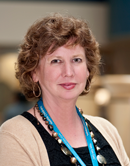

Seattle Children’s New Employee Health and Wellness Center Producing “Remarkable Results”
By Steven Hurwitz
Senior Vice President of Shared Services, Seattle Children's
By Mary-Clayton Enderlein
Director of Occupational Health Services, Seattle Children's
Read PDF of this article See all this Month's Articles
Original publish date: June 10, 2014
At Seattle Children’s, we believe providing resources to keep our workforce healthy is essential to our ability to provide high-quality care to our patients.
Employer-sponsored onsite/near-site health centers are an increasing trend to address the health and wellness needs of employees. These centers provide primary and acute care services, and serve as hubs for wellness resources, programs and education.
They also help employees overcome issues related to access, affordability, limited follow-up and non-compliance, and decrease time away from work to seek care at off-site locations.
In May 2013, Seattle Children’s opened an employee health and wellness center (EHWC) across the street from the main hospital campus. Here is a synopsis of our journey, from determining feasibility, to developing the clinic, to assessing outcomes in our first year.
Background
Seattle Children’s is a self-funded healthcare system with approximately 5,700 employees, about 4,700 who are enrolled in one of our benefits plans.
The organization has 37 sites of employment over a four-state area (Washington, Alaska, Montana and Idaho), including a 278-bed main hospital campus, four research locations and two ambulatory surgery centers.
In early 2012, leaders from Seattle Children’s Human Resources and Occupational Health Services departments explored the feasibility of creating an EHWC by looking at both employee and organizational impacts.
We examined current and projected employee health care costs while considering potential impacts of health care reform (Cadillac tax, etc). We looked at total dollars spent on healthcare claims and costs associated with the top medical conditions that drive our spending – which are largely related to preventable factors.
We determined that an EHWC made financial sense, and also believed that creating this center would stand as a testament to the organization’s commitment to our employees’ health, safety and well-being. It is one more way we demonstrate Seattle Children’s leadership not only in patient care, but care of our employees as well.
As part of our process we explored several EHWC models that offer on-site health and wellness services to employees.
Having two options – either ‘build it’ or ‘buy it’ – we concluded that engaging a vendor was a far more cost-effective and timely approach. Using an external solution requires fewer organizational resources to build, and ensures the privacy of employee health information.
Our extensive research of potential vendors led us to Vera Whole Health, located here in Seattle. Their partnership with Activate Health Care in Chicago presented an innovative and successful clinic model: incorporating primary health care with wellness services to promote optimal health outcomes, while producing projected net savings of 3.6% to 7.7% of budgeted medical claims in the first year.
Seattle Children’s Model
Seattle Children’s primary EHWC is 3,500 square feet, located across the street from the main hospital campus. It is staffed by physicians, nurse practitioners, medical assistants and health coaches. An additional clinic is located in downtown Seattle.
Both clinics guarantee same-day or next-day appointments and strive to see people with urgent needs as quickly as possible.
Vera Whole Health offers the following services to all benefit-enrolled employees:
Primary care; annual physicals; acute, episodic and urgent care; appropriate care referrals; coordination of care with an employee’s primary care provider; chronic disease prevention and management; onsite lab; onsite provider-dispensed generic medications; workers compensation treatment; wellness coaching; and biometric screenings.
Employees who are not enrolled in a Seattle Children’s benefits plan can still receive wellness services like biometric screenings and health coaching, and care for workplace injuries.
Results and Outcomes
In this first year, 1,900 Seattle Children’s employees – or 40% of benefited employees – have made over 5,000 appointments at one of our centers without receiving any additional incentives; this far exceeds the industry standard of 25% employee engagement during the initial year of operations.
Every employee fluctuates on the health care spectrum:
Well > At-Risk > Acute and High Risk > Chronically Ill > Complex/Catastrophic
Between ‘well’ and ‘catastrophically ill’ there is opportunity to make an impact on people whose health trajectory can be corrected with the right intervention at the right time.
Over one-third of Children’s employees who fall into the top three risk categories have engaged with our EHWC. The results are remarkable in terms of pounds lost, biometric markers improved, compliance with treatment plans and a decrease in hospitalizations.
In addition, through biometric screenings and physicals, over 100 employees have been identified as high-risk for chronic disease, and have engaged with the Vera team to treat and prevent further progression.
All of this helps reduce health claims and costs to both employer and employees.
Another metric we track is employee satisfaction. Vera surveys every employee following their visit and the results show a 4.8 out of 5 satisfaction rating with all services. Employees consistently express their appreciation for adding this benefit at no cost to them that meets so many of their health and wellness needs close to their workplace.
What’s on the Horizon
As we move into the next phase of our journey, we are evaluating additional health and wellness services to offer employees.
It is exciting to see Seattle Children’s emerging as a model for an innovative and proactive approach to address the health and wellness needs of employees. We have been privileged to share our experience and results at conferences around the country, and hope to inspire other organizations to consider implementing an EHWC.
Steven Hurwitz is currently the Senior Vice President of Shared Services (Human Resources, Marketing, Supply Chain and Home Care Services) for Seattle Children’s. Steven joined Children’s in 2008 as Vice President of Human Resources. Steven creates strategic alignment with his executive counterparts to ensure that integrated and leveraged solutions are realized throughout the organization.
Prior to joining Children’s, Steven worked for Starbucks Coffee for 9 years with his last role being Vice President, Human Resources. Steven also brings diverse experiences from Nabisco Biscuit Company, Macromedia Corporation and Harris Corporation.
Steven earned a Bachelor’s degree from Hofstra University and both an MBA in General Business and Master’s degree in Organization Development from the Florida Institute of Technology. Steven has served on the Board of Directors for Big Brothers Big Sisters, and for Providence Senior and Community Services.
Mary-Clayton Enderlein joined Seattle Children’s as Director of Occupational Health Services in February 2010. Her responsibilities include overseeing the overall health, safety and wellbeing of Seattle Children’s workforce. She has over thirty years of nursing, education, project and clinical management experience in the fields of health care, wellness and education.
Prior to joining Children’s, Mary-Clayton founded and directed a business focused on providing health and wellness solutions to individuals, community groups and corporations locally and nationally.
Mary-Clayton received her Bachelor of Science in Nursing (BSN) from Georgetown University and both a Master’s of Public Health (MPH) and Doctorate of Nursing Practice (DNP) from University of Washington. She is also an Advanced Registered Nurse Practitioner (ARNP) and credentialed as a Family Nurse Practitioner.